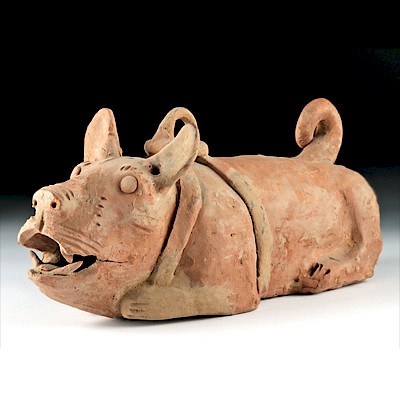Colima Redware Olla w/ Faces
Lot 70a
About Seller
Artemis Fine Arts
686 S Taylor Ave, Ste 106
Louisville, CO 80027
United States
Selling antiquities, ancient and ethnographic art online since 1993, Artemis Gallery specializes in Classical Antiquities (Egyptian, Greek, Roman, Near Eastern), Asian, Pre-Columbian, African / Tribal / Oceanographic art. Our extensive inventory includes pottery, stone, metal, wood, glass and textil...Read more
Estimate:
$2,000 - $3,000
Absentee vs Live bid
Two ways to bid:
- Leave a max absentee bid and the platform will bid on your behalf up to your maximum bid during the live auction.
- Bid live during the auction and your bids will be submitted real-time to the auctioneer.
Bid Increments
| Price | Bid Increment |
|---|---|
| $0 | $25 |
| $300 | $50 |
| $1,000 | $100 |
| $2,000 | $250 |
| $5,000 | $500 |
| $10,000 | $1,000 |
| $20,000 | $2,500 |
| $50,000 | $5,000 |
| $100,000 | $10,000 |
| $200,000 | $20,000 |
About Auction
By Artemis Fine Arts
Sep 13, 2018
Set Reminder
2018-09-13 10:00:00
2018-09-13 10:00:00
America/New_York
Bidsquare
Bidsquare : Ancient | Asian | Ethnographic - Fall Variety
https://www.bidsquare.com/auctions/artemis-gallery/ancient-asian-ethnographic---fall-variety-3432
Travel the world and back in time... Antiquities from Egypt, Greece, Italy and the Near East, Asian, Pre-Columbian, African / Tribal / Oceanic, Native American, Spanish Colonial, Russian Icons, Fine Art, much more! Artemis Fine Arts info@artemisgallery.com
Travel the world and back in time... Antiquities from Egypt, Greece, Italy and the Near East, Asian, Pre-Columbian, African / Tribal / Oceanic, Native American, Spanish Colonial, Russian Icons, Fine Art, much more! Artemis Fine Arts info@artemisgallery.com
- Lot Description
Pre-Columbian, West Mexico, Colima, Protoclassic period, ca. 100 BCE to 250 CE. A huge, hand-built pottery olla with a wide, rounded base, curving walls, smooth shoulders, a deep interior cavity, and a squat neck with a flared rim. Noteworthy to this highly-burnished vessel are the eight abstract anthropomorphic faces spaced equidistantly around the midsection of the body, each displaying circular eyes, protruding noses, miniscule mouths, puffy cheeks, and mounded foreheads. Covered in a deep vermilion slip, this is a fabulous example of high-quality shaft tomb pottery! Size: 11" W x 7.875" H (27.9 cm x 20 cm).
Colima, located on Mexico's southwestern coast, was during this time part of the shaft tomb culture, along with neighbors to the north in Jalisco and Nayarit. In this culture, the deceased were buried down shafts - ranging from 3 to 20 meters deep - that were dug vertically or near vertically through the volcanic tuff that makes up the geology of the region. The base of the shaft would open into one or more horizontal chambers with a low ceiling. These shafts were almost always dug beneath a dwelling, probably a family home, and seem to have been used as family mausoleums, housing the remains of many related individuals. Vessels like this one were placed in the tombs in order to hold offerings.
Provenance: private Santa Fe, New Mexico, USA collection; ex-collection of Alan Davis, Santa Fe, New Mexico, USA
All items legal to buy/sell under U.S. Statute covering cultural patrimony Code 2600, CHAPTER 14, and are guaranteed to be as described or your money back.
A Certificate of Authenticity will accompany all winning bids.
We ship worldwide and handle all shipping in-house for your convenience.
#138149Surface wear and abrasions commensurate with age, very minor nicks to rim and some faces, with fading to some faces and areas of coloration, otherwise intact and excellent. Nice earthen and mineral deposits and light encrustations throughout. Several small, thin felt pads on base for stabilization.Condition
- Shipping Info
-
All shipping is handled in-house for your convenience. Your invoice from Artemis Gallery will include shipping calculation instructions. If in doubt, please inquire BEFORE bidding for estimated shipping costs for individual items.
-
- Buyer's Premium



 EUR
EUR CAD
CAD AUD
AUD GBP
GBP MXN
MXN HKD
HKD CNY
CNY MYR
MYR SEK
SEK SGD
SGD CHF
CHF THB
THB
















